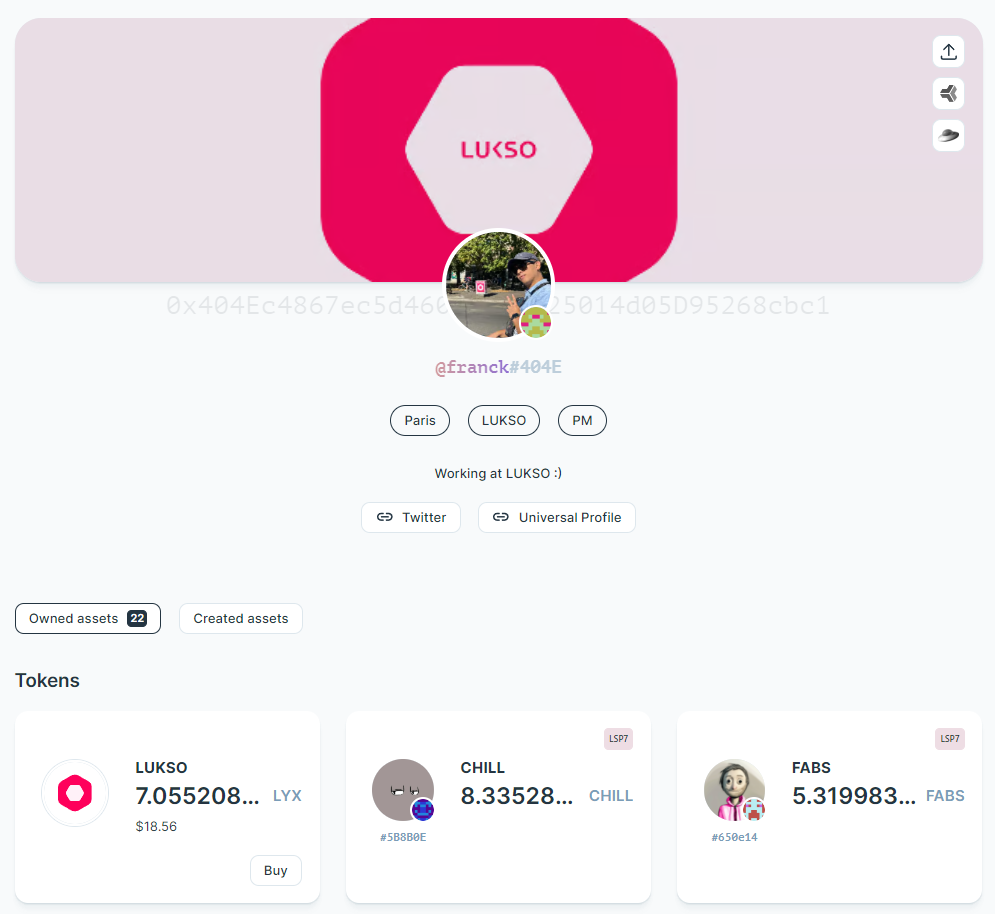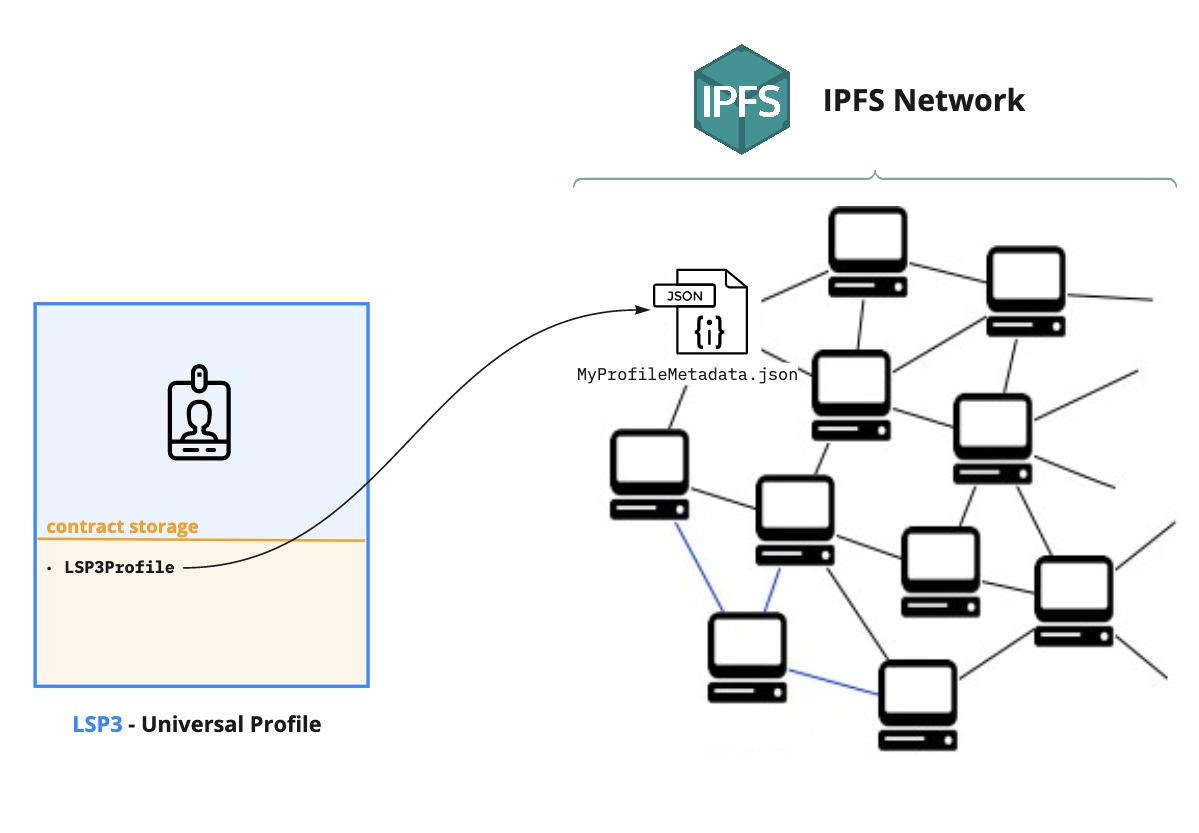Edit a Universal Profile
This guide will teach you how to customize our Universal Profile programmatically in JavaScript and includes:
- adding a profile and cover picture to our Universal Profile,
- editing our Universal Profile infos (e.g., description, badges, links),
- see the updated profile details and images of our Universal Profile on the wallet.universalprofile.cloud website.
To achieve this goal, we will perform the following steps:
- Create a JSON file that contains your profile details (
LSP3Profilemetadata). - Upload this JSON file to IPFS using our tools-data-providers library.
- Set your new profile metadata key to your Universal Profile with our erc725.js library and
web3.js.

Install the dependencies
For this guide, we will use the tools-data-providers, erc725.js and lsp-smart-contracts libraries:
npm install web3 @lukso/lsp-smart-contracts @erc725/erc725.js @lukso/data-provider-ipfs-http-client
Create a new LSP3Profile JSON file
LSP3ProfileMetadata.json (example) - Complete "ready to use" JSON file
{
"LSP3Profile": {
"name": "Universal Profile - Edit Profile Data",
"description": "Congratulations! You have successfully edited your profile!",
"links": [
{
"title": "Website",
"url": "https://mywebsite.me"
}
],
"tags": ["Public Profile"],
"profileImage": [
{
"width": 640,
"height": 609,
"hashFunction": "keccak256(bytes)",
"hash": "0xe459e5769af85b09fb43bb8eaac561e196d58c0f5da3c5e150b6695898089402",
"url": "ipfs://QmPCz896rcZmq8F3FuUkJinRUmPgnZGjPvZL71nAaL7Fsx"
}
],
"backgroundImage": [
{
"width": 1024,
"height": 576,
"hashFunction": "keccak256(bytes)",
"hash": "0x1c19780d377a7b01f7dcf16e0ebffd225e29d2235625009f67cf9d86a32a79e1",
"url": "ipfs://QmPMmEpKnmgACsWjhDUheF8TEKpspzQhAkjbY4EBbR4jgP"
}
]
}
}
We will start by creating a new JSON file that will contain our LSP3Profile metadata.
{
"LSP3Profile": {
"name": "...", // a self chosen username
"description": "...", // A description, describing the person, company, organisation or creator of the profile.
"links": [
// links related to the profile
{
"title": "...", // a title for the link.
"url": "..." // the link itself
}
// add more links...
],
"tags": ["...", "..."], // tags related to the profile
"profileImage": [
{
"width": 640, // in pixels
"height": 609, // in pixels
"hashFunction": "keccak256(bytes)", // do not change!
"hash": "0x...", // add the keccak256 hash of the image here
"url": "ipfs://..." // IPFS image identifier (CID)
}
],
"backgroundImage": [
{
"width": 1024, // in pixels
"height": 576, // in pixels
"hashFunction": "keccak256(bytes)", // do not change!
"hash": "0x...", // add the keccak256 hash of the image here
"url": "ipfs://..." // IPFS image identifier (CID)
}
]
}
}
Add more details to your profile:
Add more details about the Universal Profile for the entity's name, description, links, and tags. The properties links and tags accept an array of objects or strings, so you can add as many as you need!
Be as creative as you want to make your Universal Profile as unique as possible! 🎨
The JSON file for LSP3Profile accepts an array of images so that you have pictures of different sizes and dimensions. This way, client interfaces can know which files to pick based on the container size in their interface.
Upload data to IPFS
In this guide, we will use local IPFS Node provider from our IPFS Provider Tool. Other providers supported by this tool including Pinata, Infura, Cascade and Sense.
This guide will store our Universal Profile metadata on IPFS. We can add edit our UP metadata by:
- Creating a new JSON file with new or updated info (☑️ done in the previous step).
- Uploading the file to IPFS.
- Change the reference of our LSP3Profile key to point to our uploaded JSON file.

Upload image to IPFS
For the properties profileImage and backgroundImage, we will need to add the following information:
hash: the keccak hash of the image fileurl: the url of the image uploaded to IPFS.
Both hash and url values can be obtained from using our IPFS library.
import { createReadStream } from 'fs';
import { IPFSHttpClientUploader } from '@lukso/data-provider-ipfs-http-client';
const provider = new IPFSHttpClientUploader('http://127.0.0.1:5001/api/v0/add');
const file = createReadStream('./test-image.png');
const { url, hash } = await provider.upload(file);
Image sizes should be written as numbers, not as strings. The max image widths supported by universalprofile.cloud are:
profileImage <= 800px, backgroundImage <= 1800px
Upload JSON Metadata to IPFS
Same as the image, we need to gather the hash and url values of the uploaded JSON Metadata.
import { IPFSHttpClientUploader } from '@lukso/data-provider-ipfs-http-client';
// reference to the previously created JSON file (LSP3Profile metadata)
import jsonFile from './LSP3Metadata.json';
const ipfsProvider = new IPFSHttpClientUploader(
'http://127.0.0.1:5001/api/v0/add',
);
const provider = 'https://4201.rpc.thirdweb.com'; // RPC provider url
async function editProfileInfo() {
// Upload our JSON file to IPFS and retrieve url and hash values
const { lsp3ProfileIPFSUrl, lsp3ProfileIPFSHash } = await ipfsProvider.upload(
jsonFile.LSP3Profile,
);
}
We are now ready to apply these changes to our Universal Profile. We will see how in the next section. ⬇️
Encode the LSP3Profile Metadata
The next step is to prepare the data used to edit our Universal Profile. Preparing the data means encoding it to write in on our Universal Profile ERC725Y smart contract.
To do so, we will use our erc725.js library, which helps us encode the data easily. We will need the following:
- The address of our Universal Profile contract mentioned in the URL on the universalprofile.cloud explorer
- An ERC725Y JSON Schema: a set of ERC725Y key-value pairs (LSP2 - ERC725Y JSON Schema)
- A RPC provider:
https://4201.rpc.thirdweb.com
Once our erc725.js is initialized, we can encode the LSP3Profile data to generate a key and a value.
To do so, we use the encodeData() function. We call it with an object containing the keyName and the value:
keyName:LSP3Profile, the name of the key we want to encode.value: an object with:hashFunction: we usekeccak256(standard hash function). Since we are hashing a JSON file that contains strings, we also specify the data type asutf8.hash:obtained after hashing the JSON file withkeccak256. (as lsp3ProfileIPFSHash)urlof the file: this is the IPFS URL of the file obtained in the previous step. (as lsp3ProfileIPFSUrl)
import Web3 from 'web3';
// import ERC725
import { ERC725 } from '@erc725/erc725.js';
// ...
const web3 = new Web3('https://4201.rpc.thirdweb.com');
// Create a new LSP3Profile JSON file
// ...
async function editProfileInfo() {
// Upload our JSON file to IPFS
// ...
// Setup erc725.js
const schema = [
{
name: 'LSP3Profile',
key: '0x5ef83ad9559033e6e941db7d7c495acdce616347d28e90c7ce47cbfcfcad3bc5',
keyType: 'Singleton',
valueType: 'bytes',
valueContent: 'VerifiableURI',
},
];
const erc725 = new ERC725(schema, profileAddress, web3.currentProvider, {
ipfsGateway: 'https://api.universalprofile.cloud/ipfs',
});
// Encode the LSP3Profile data
const encodedData = erc725.encodeData({
keyName: 'LSP3Profile',
value: {
hashFunction: 'keccak256(utf8)',
hash: lsp3ProfileIPFSHash,
url: lsp3ProfileIPFSUrl,
},
});
/**
{ example keys & values
keys: ['0x5ef83ad9559033e6e941db7d7c495acdce616347d28e90c7ce47cbfcfcad3bc5'],
values: ['0x6f357c6aabbbf0d07b125d2c53c1ca19672e31ad768d8fd2ca55fbf0a6e94a39488a52c5697066733a2f2f516d59435154653572355a6556546274705a4d5a58535150324e785864674a46565a623631446b33674650355658']
}
*/
}
Edit the Universal Profile
Now that our updated data is encoded, we are ready to set it in our Universal Profile smart contract.
Create instance of UP
The first step is to create an instance of the Universal Profile smart contract. We will need:
- the contract ABI (from our npm package
@lukso/lsp-smart-contracts). - the address of the Universal Profile contract.
import Web3 from 'web3';
import UniversalProfile from '@lukso/lsp-smart-contracts/artifacts/UniversalProfile.json';
const web3 = new Web3('https://4201.rpc.thirdweb.com');
const myUP = (await web3.eth.getAccounts())[0];
// Create instance of our UP
const universalProfileContract = new web3.eth.Contract(
UniversalProfile.abi,
profileAddress,
);
Set data on the Universal Profile
The final step is to edit our LSP3Profile key on our Universal Profile with the new value obtained in Step 3. We can easily access the key-value pair from the encoded data obtained with erc725.js.
// Update LSP3Profile metadata on our Universal Profile
await universalProfileContract.methods.setData(
encodedData.keys[0],
encodedData.values[0],
).send({ from: myEOA.address });
You can also validate your LSP3Profile metadata of your Universal Profile using the ERC725 Inspect Tool.

Visualize our updated Universal Profile
You can now check your UP on the profile explorer website (make sure you are on the correct network - there is a network switch in the footer):
https://wallet.universalprofile.cloud/[UP ADDRESS]?network=testnet